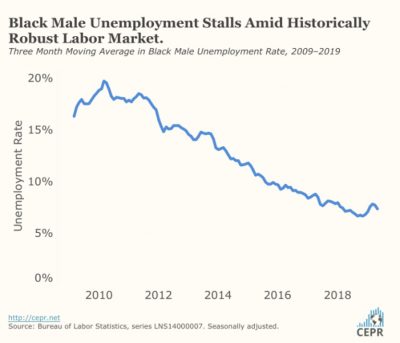By Dean Baker – Center for Economic Policy and Research
June 07, 2019 – The Bureau of Labor Statistics (BLS) reported that the economy added just 75,000 jobs in May. In addition, the prior two months growth numbers were revised down by 75,000, leaving the three month average at 151,000. The unemployment rate was unchanged at 3.6 percent, and the employment-to-population rate (EPOP) was also unchanged at 60.6 percent. The EPOP for prime age workers (ages 25 to 54) was also unchanged at 79.7 percent.
While the slower job growth reported for May is discouraging, probably the most disconcerting aspect of the report is the evidence that wage growth is actually slowing in spite of the 3.6 percent unemployment rate. The year-over-year rate of increase in the average hourly wage was 3.1 percent, down from a peak of 3.4 percent earlier this year.
The annualized rate of wage growth when comparing the last three months (March, April, and May) with the prior three months (Dec ember, January, and February) was just 2.7 percent.
Black unemployment fell 0.5 percentage points to 6.2 percent. For black men it also dropped by 0.5 percentage points to 6.9 percent. Earlier in the year, the unemployment rate for black men had been over 7.0 percent. Even with the May decline, it’s still unchanged from its year ago level. By comparison, at 3.2 percent, the unemployment rate for white men is 3.5 percentage points below its year ago level.
The slower job growth hit pretty much every sector in May. Construction added just 4,000 jobs in May, while manufacturing added 3,000. This compares to an average monthly growth over the last year of 17,900 and 15,300, respectively. Manufacturing has been looking especially weak in recent months, as average hours have been dropping.
The index of aggregate hours worked in manufacturing is at the same level as it was last August. Wage growth has also been exceptionally weak in manufacturing, with the average hourly wage up just 2.2 percent over the last year.
Retail lost 7,600 jobs, with a loss of 12,700 jobs in clothing stores being the main factor. This is the fourth consecutive month of job loss in the sector. Employment is now down by 75,700 (0.5 percent) over the last year. Health care added just 15,700 jobs in May, the slowest growth since September of 2017.
That compares to an average of 32,500 over the last year. Restaurants added 16,900 jobs in May, down from an average of 25,100 over the last year. State and local education lost 14,400 jobs, although this could be a seasonal adjustment issue. The motion picture industry lost 1,800 jobs in May, employment is now down 24,200 (5.5 percent) over the last year.
While most of the data in the establishment survey was negative, the household survey was more mixed. There was a drop of almost 300,000 in the number of people involuntarily working part-time. This pushed down the broader U-6 measure of unemployment by 0.2 percentage points to 7.1 percent, the lowest level of the recovery to date.
The share of unemployment attributable to voluntary quits jumped to 13.5 percent, the third highest level of the recovery, although a share that is still below the peak of over 15.0 percent reached in 2000.








